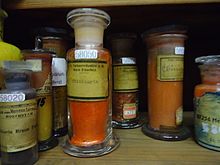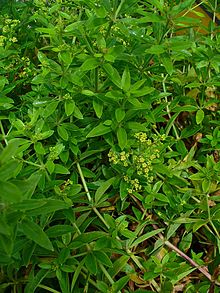Quinizarin
| Structural formula | |||||||||||||||||||
|---|---|---|---|---|---|---|---|---|---|---|---|---|---|---|---|---|---|---|---|

|
|||||||||||||||||||
| General | |||||||||||||||||||
| Surname | Quinizarin | ||||||||||||||||||
| other names |
|
||||||||||||||||||
| Molecular formula | C 14 H 8 O 4 | ||||||||||||||||||
| Brief description |
yellow-red leaflets or deep red needles |
||||||||||||||||||
| External identifiers / databases | |||||||||||||||||||
|
|||||||||||||||||||
| properties | |||||||||||||||||||
| Molar mass | 240.20 g mol −1 | ||||||||||||||||||
| Physical state |
firmly |
||||||||||||||||||
| Melting point |
|
||||||||||||||||||
| solubility |
soluble in water, ethanol , diethyl ether and benzene |
||||||||||||||||||
| safety instructions | |||||||||||||||||||
|
|||||||||||||||||||
| Toxicological data | |||||||||||||||||||
| As far as possible and customary, SI units are used. Unless otherwise noted, the data given apply to standard conditions . | |||||||||||||||||||
Quinizarin is an organic-chemical aromatic compound. It is an anthraquinone dye related to alizarin .
Occurrence
Like other anthraquinones, quinizarin occurs in the roots of the madder .
presentation

A number of synthesis options are described in the literature. Quinizarin can be obtained from the reaction between phthalic anhydride and hydroquinone . Aluminum chloride can be used as Lewis acid for this purpose . Another synthetic route is given by the reaction of 1,4-dihydroxynaphthalene with maleic anhydride and aluminum chloride. Quinizarin can also be produced by reducing the purpurine in a weakly alkaline, neutral or acidic solution, or with glacial acetic acid and zinc dust .
use
The dye is orange in its protonated form. When adding hydroxide ions, the dye turns violet. Thus it can be used as a pH indicator.
Individual evidence
- ↑ a b c Entry on quinizarin. In: Römpp Online . Georg Thieme Verlag, accessed on March 28, 2014.
- ↑ a b c Quinizarin data sheet from Sigma-Aldrich , accessed on May 25, 2011 ( PDF ).
- ^ Entry on quinizarin in the ChemIDplus database of the United States National Library of Medicine (NLM) .
- ↑ Goverdina CH Derksen, Harm AG Niederländer and Teris A. van Beek: Analysis of anthraquinones in Rubia tinctorum L. by liquid chromatography coupled with diode-array UV and mass spectrometric detection , in: Journal of Chromatography A , 2002 , 978 (1- 2), pp. 119-127; doi : 10.1016 / S0021-9673 (02) 01412-7 .
- ↑ H. Raudnitz: About 5.8-Dioxy-alpha-anthrapyridinequinones , in: Chem. Ber. , 1929 , 62 , pp. 509-513; doi : 10.1002 / cber.19290620310 .
- ↑ K. Zahn, P. Ochwat: On the constitution and reaction of polynuclear polyoxyquinones. About naphtazarin and quinizarin , in: Liebigs Annalen , 1928 , 462 , pp. 82-97; doi : 10.1002 / jlac.19284620105 .
- ^ Rudolf Bauer, Heinrich Wieland: Reduction and hydrogenation of organic compounds . Springer-Verlag, 1918, ISBN 978-3-662-33872-8 , p. 56 ( limited preview in Google Book search).

